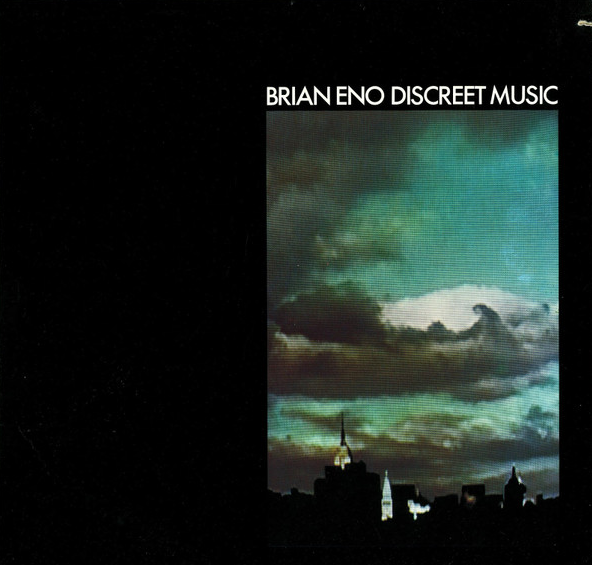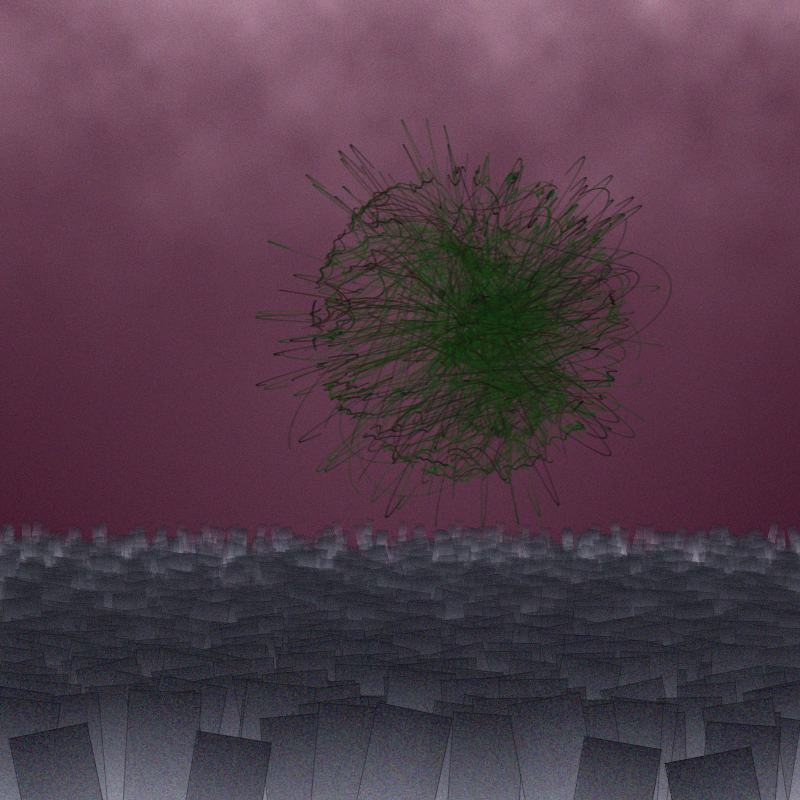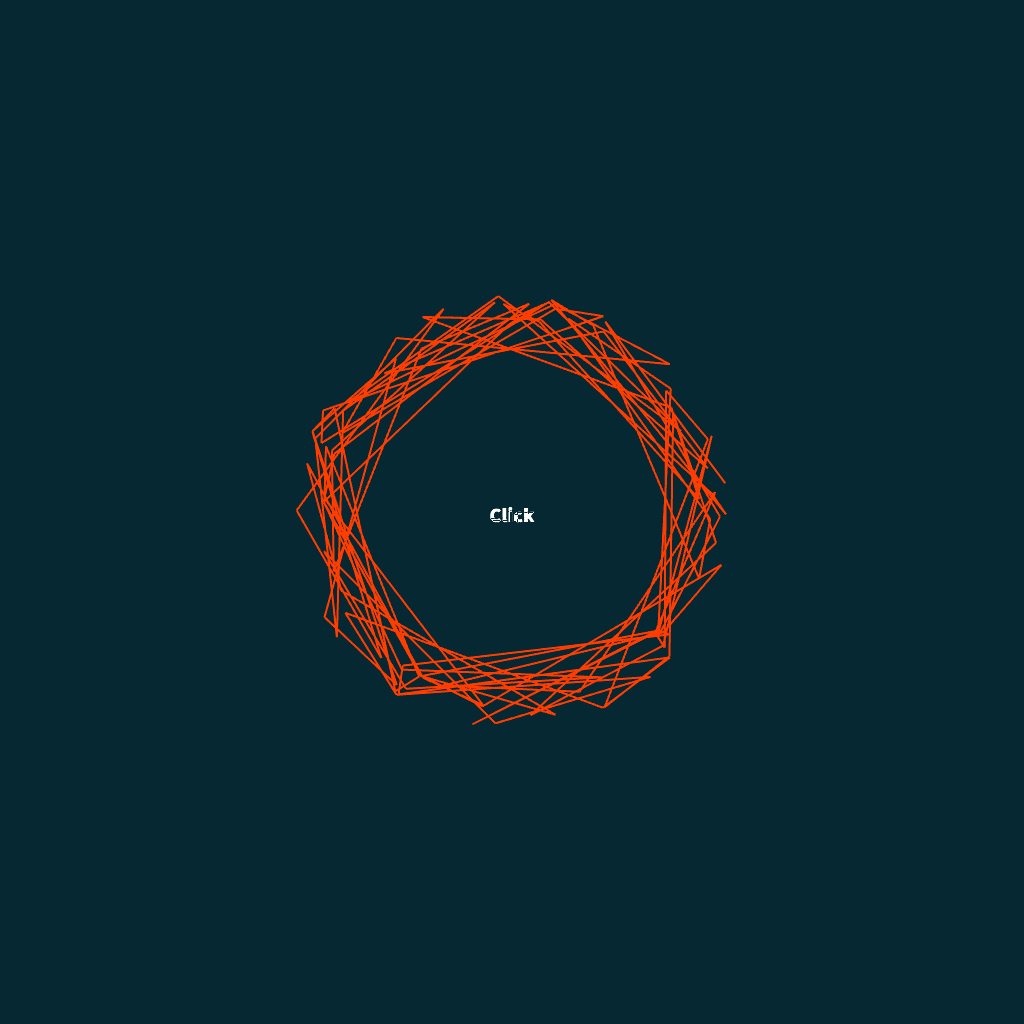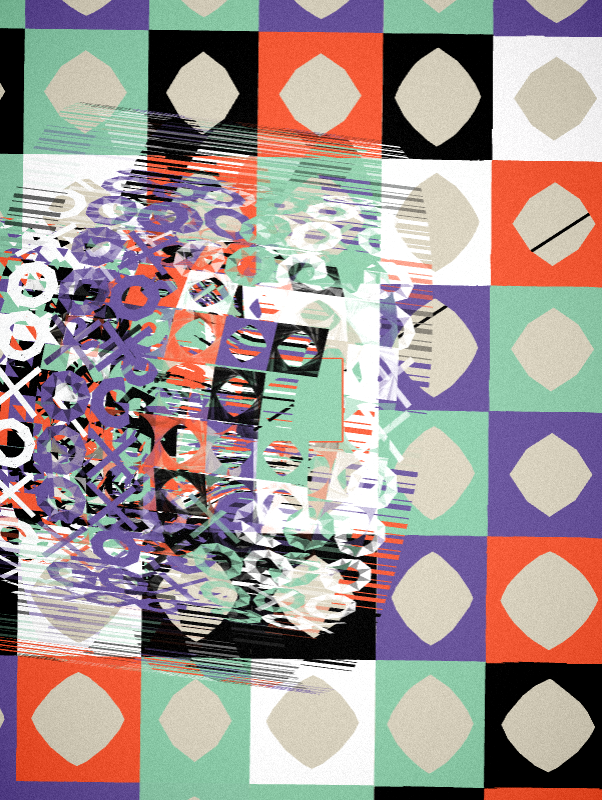
Generative Music - A Brief History and Future
written by Erik-West
In the early 90s, I was introduced to Brian Eno's Discreet Music (1975) by a college roommate who used Side A as background music to his power naps. It was an absolute tonic; subtle, melodic and lulling, the ever-shifting sounds were the perfect complement to closing your eyes for 23 minutes between classes. I borrowed it as often as I could and picked up my own copy in later years.
On the front cover of the US-issued LP is a photo taken from a video of a New York City skyline. On the back, Eno diagrams his processes and describes what led to this monumental work. He goes into detail on the record's entire construction, from its hospital stay influence, to its creation and production. It's a fantastic read and remains a great glimpse into the setup of Eno's generative ideals:
Eno included the above diagram to not only show the listener the full process of how the record was created, but offering anyone the capability to recreate each step for themselves. It wasn't until 1995 that Eno used the term 'generative music' to describe music that is "ever-different and changing, and that is created by a system". He would move from manipulating tape loops to using Koan generative software (eventually recreated as Wotja) to create new systems, but the general output was the same -- music that would change continuously, and never repeat itself.
While Eno may have created the term, he wasn't the first to use automated or random processes to create music. Years earlier Steve Reich used a series of tape recorders to create It's Gonna Rain, and there are generative elements used throughout Delia Derbyshire's 60's electronic music act Unit Delta Plus. Roland Kayn likely used generative processes in the creation of Tektra (1984). Randomized variations of music have been around for at least as long as Musikalisches Würfelspiel, a popular musical dice game in the 18th Century. And well before that, it can be argued, African drummers used polyrhythms to play a different rhythmic pattern overtop another pattern, forming the genesis to what we now know as generative formations in music.
Although generative works of art and music have been documented for decades, it wasn't until the rise of blockchain technology that a near perfect use-case would be formed with NFTs, and a final component could be put in place – the ability for the listener to begin playing a piece, and have it continue playing, endlessly.
For the rest of this article, I intend to highlight a few historical items, as well as some stellar examples of generative music NFTs -- on Tezos & fxhash -- as well as on Ethereum. This is by no means comprehensive. Links will be updated in the future to allow for dynamic content outside of fxhash. Also, keep in mind this is in a very loose historical order, so if I got anything wrong feel free to let me know. Let’s dive right in!
[object Object]
Released in March of 2021 on Ethereum, EulerBeats was a generative audio project that minted 27 unique beat recordings and sold out nearly instantly. You can still mint prints of each of the 27 originals, until a cap is met at 119 copies of each. As for their sound? Quite dated, with muted synth and subtle backbeats. Each one lasts around two minutes.
As one of the first generative audio projects offered as an NFT, it offered a unique mechanism in the form of a bonding curve, wherein longer-term holders could burn their beats for more ETH than they were purchased for, allowing for some nice returns for early buyers, but only if (and when) more prints are purchased. The highest print # of any Eulerbeat (the #1 beat) is, now, at 57, less than half of the cap, and priced at a less-than-affordable 3.54 ETH. While unique, this financial aspect diminishes much of any artistic merit for me, and makes it seem more like a game than anything else. But as one of the first generative audio projects offered as an NFT, it ss a unique test of popularity vs. exclusivity.
[object Object], - notjamesmurphy
Released on the Tezos-based Hic Et Nunc in July of 2021, this piece is subtitled as “One composition, infinite permutations. No two versions are ever the same. Each composition plays endlessly, subtly evolving over time.” Murphy calls his pieces aleatoric, not necessarily generative, but both terms could be used in the case of these works. Aleatory compositions, or 'chance' music, is a loose term describing music that can be either improvised in sections, started in different places, or given vague directives ie. "play loud for five minutes, at this point”, or "improvise at this point."
The material itself is minimal, and melodic, with an occasional cascading, symphonic feel. These pieces are also non-deterministic, so a refresh of the browser tab will play an entirely new composition based on the algorithm programmed. Murphy is planning on releasing an fxhash piece soon, and I’m hoping to do a more in-depth writeup on his processes and the piece as the time nears.
[object Object]
Released in July of 2021 on Art Blocks as a collaboration between kaigani and Dadabots, ByteBeats was influenced by a coding challenge from ten years earlier by a computer artist named Viznut, titled “Algorithmic symphonies from one line of code – how and why?” In a nutshell, here's the description from Art Blocks release page:
Generative music in 40-140 bytes on-chain. ByteBeats are miniature functions that synthesize audio (and video) via bitwise operations (&^|<<*+/%>>)
Sometimes glitchy, sometimes manic, the randomness of the harmonies can at times be straining on the ears. Notes on this project indicate that while most of these will play endlessly, some will loop, and Dadabots have set up a website where you can listen to your purchased ByteBeat and see what it will sound like in 1 minute, or 10 minutes, or, as in the above image -- 3,528 years from now.
[object Object], by ,[object Object]
Click here for a link to see the dynamic content. Press the space bar to turn audio on and off.
Released via Art Blocks Factory in August of 2021 in an edition of 180, CryptoGodKing is a generative piece combining illuminati imagery -- eyes gazing in different directions, triangles inverted and upright -- with swirling vortexes of shifting formations. Clicking the spacebar in full screen elicits subtle low-end frequencies. Here's the artist explaining the audio to me, in layman's terms:
"You get the wobbly effect from having another oscillator going at a slightly different frequency, so doing that with a base tone, and then again with a pleasing multiple of the base tone."
The visuals are all stellar, but the addition of the generative audio puts this one over the top for me. I made the mistake of selling one of these last year, immediately regretted it, and wound up buying another one the next day.
[object Object], by ,[object Object],x ,[object Object]
Click here to view the dynamic content.
Released on Art Blocks via Bright Moments, Venice Beach, in September 2021, Rituals merges the calm, flowing energy of Aaron Penne's transcendent artwork with meditative audio by Justin Boreta, of Glitch Mob fame. It's a beautiful mix. I've only heard 20 or so of the 1000, but the ones that I've discovered flow together perfectly, creating a very calming atmosphere or glimpse into a "singular parametric universe."
As with most generative compositions, the music and art here are created with infinity in mind, and according to the description "if left running, a single Ritual will continue generating music and art for ~9 million years." On the ones I sampled, the tones here are subtle, with rich and deep harmonics and layers of shifting, or phased low-end. Occasionally, you'll come across one with a higher range and melody. As for the art, well, it's Aaron Penne. If you are a fan of generative art, more than likely you know his name. His work is ever-evolving in pieces, but incredibly subtle. Great stuff.
And now, for our first fxhash entrant...
Sound Check by Idlebit
project name project name project name
Idlebit's Sound Check was the 10th project released on fxhash on November 11th, selling for 0.1Tz – at the time, about $0.60USD. Since then, the artist has released the impressive Rondelle, Listen, as well as a handful of other great projects. Billed as a proof-of-concept, Sound Check remains a fun piece, and I love collecting more of these over time. It's such a simple piece – click to run, click off the piece to stop, but I love the variations of audio on each one. Contrasting colors present the visual, and the graphics react to the audio that is generated. Oh, and they’re now about 25Tz. on secondary.
Drone Beast Synthesizer by ferluht
project name project name project name
An interactive piece that contains a modular synthesizer, ferluht released only 88 of these in late January of 2022, a couple of weeks after releasing his debut synth project on the platform, Ambient Landscapes Synthesizer. It’s noisy, abrasive at times, drony, heavy and I just love all of them. Here’s a more technical rundown of the process from the release page:
This is a little Drone Beast with a modular synthesizer inside. Being made of thousands of particles swarming around several attractors it reacts on different signals across the modular patch. The patch itself is based on multiple 8-bit oscillators, modulating each other and being modulated by mathematical expressions, unique for each Beast.
I sadly missed this drop and have been scrambling to find the Tez to buy one of these. So if you purchased this article, know that in good faith I may have likely used the proceeds to buy one for my collection!
Basil and Timbre by Rami Awad
project name project name project name
Rami Awad has done some of my favorite generative audio pieces on the fxhash platform. Since January of 2022, the artist has consistently released a variety of works which allow the user to interact with each piece and change musical variables within them, from the melody (Basil) to low frequencies (Timbre).
Where do I begin with Basil? On the project page, Awad describes it quite simply as an Interactive generative music system.
It contains a visual element and some degree of interactivity, allowing the user to modify the shape of the melody based on how the image stands in a three-dimensional plane. It's one of my favorites from this year, and I continue to find myself collecting more and more examples of them.
project name project name project name
Timbre uses amplitude modulation synthesis to modulate one synth based on the output of another, with the ratio between the signals affecting the timbre of the output -- this leads to some fascinating, low-tone pulsating waves that loop endlessly. If you keep Basil running, above, you’ll hear some nicely layered, complimentary sounds. I often have multiple tabs open, and have often kept a few variations of Rami’s pieces going throughout the day. At of the time of this writing, it has yet to mint out, and at a price of 5 tez, it's unbelievably affordable to get one of your own.
Element by Kaitlyn Raitz & Jana Stýblová
Click here to listen to Edition #3
The first classical music released on ETH-based Async Art’s new Blueprints label, Element combines components of a traditional string quartet to form unique pieces of music, based on the elements, to raise awareness of climate change. It's an ambitious piece; symphonic, sparse and heavy in places, I greatly enjoy hearing the results. From the release:
Element
translates the sounds of the natural world into the language of the string quartet with two types: before and after the destruction of natural resources caused by industrialization, colonization, and overconsumption. Each layer of the string quartet (violin 1, violin 2, viola, and cello) has four different states (fire, water, air, and earth) that are each played differently.
It's also among one of the few projects mentioned here that has yet to mint out, and is priced at a relatively affordable .064ETH
Montreal Friend Scale by Amon Tobin
Click here to see/listen to the generative content.
I’d be extremely remiss if I didn’t include this amazing collection in an article on generative audio NFTs, which was released on Art Blocks in June of this year in an edition size of 500. For those who don’t know, Amon Tobin is a Brazilian musician, composer and producer who releases works via the vaunted Ninja Tune label. This project is complex, and quite simple at the same time, beginning with white noise and the selectively filtering out narrow frequency bands, leaving cascading, ghostly loops in place. It’s fantastic, and one of the best generative audio projects I’ve come across. From the description:
visually, the white noise is represented by particles which congeal into dense lines. each line that appears is a specific note you can hear and it's amplitude is defined by the corresponding particle density. chords are represented by the lines crossing over each other. so in summary, it's a quite literal visual representation of sound moving from an arbitrary form to musical form. natural order from chaos with infinitely variable patterns depending on which notes are audible.
They sold out quickly and can currently be found for about .70ETH on OpenSea
Distortion City #1 by Jinyao Lin
project name project name project name
Jinyao Lin's debut project on fxhash, released in late November of last year, is essentially a graphical representation of distorted harmonics. I love how simple this is, with three sets of numbers in the lower left corner representing the color (static) and two conflicting frequencies, the distorted harmonics. This is another one that I'll occasionally run in a spare tab throughout the day.
Toccata by Andreas Rau and Marcelo Soria-Rodríguez
project name project name project name
Released this past September as a part of the fx(collab) series on fxhash, this work was given the unofficial name of Toccata after Prokofiev's Toccata in D Minor, Op. 11 -- and it stuck, according to the well written website that accompanied this release.
Now, hear me out. While amazing visually, I've found the naked simplicity of the music becomes more and more the focal point. It is minimally played, courtesy of Rau's family piano. Chords and notes cascade, decay and layer in a way that conveys a strong sense of emotional depth. The beauty of ghostly deterioration and reduction is a present all over this piece, and yet it’s impossible to convey in words. It is something you simply must hear, and see, for yourself.
project name project name project name
The piece is so beautiful, and remains truly one of the best examples of generative art that I've ever seen -- on fxhash, or anywhere. Time will tell if it holds up to the accolades already bestowed upon it, but I think the word hasn't even started spreading. It's truly an amazing collaboration, and an amazing work of art.
The Future from Someone Bad at Predictions
So where to now? Despite these examples, generative music is still a newborn compared to the relative infancy of the entire NFT space. It's day in the sun is still a ways off. But perhaps soon we'll hear of bands releasing 512 iterations of their albums, or more composers releasing 128 variations of a symphony. Perhaps we'll see variations in timing and quality, whereby a lower bitrate recording could morph over decades into something transparent and clear, or, as in Toccata's case, the opposite. I dream of hearing Brian Eno's next release in a truly generative way, instead of by streaming or buying a single version, with a set beginning and ending. That would be my dream. But I will always revisit Discreet Music on vinyl.
Time will tell, but I have the feeling something amazing is right around the corner.
If you have any feedback, I'd love to hear it! Feel free to reach out to me on Twitter, and thanks for reading. Cheers!






